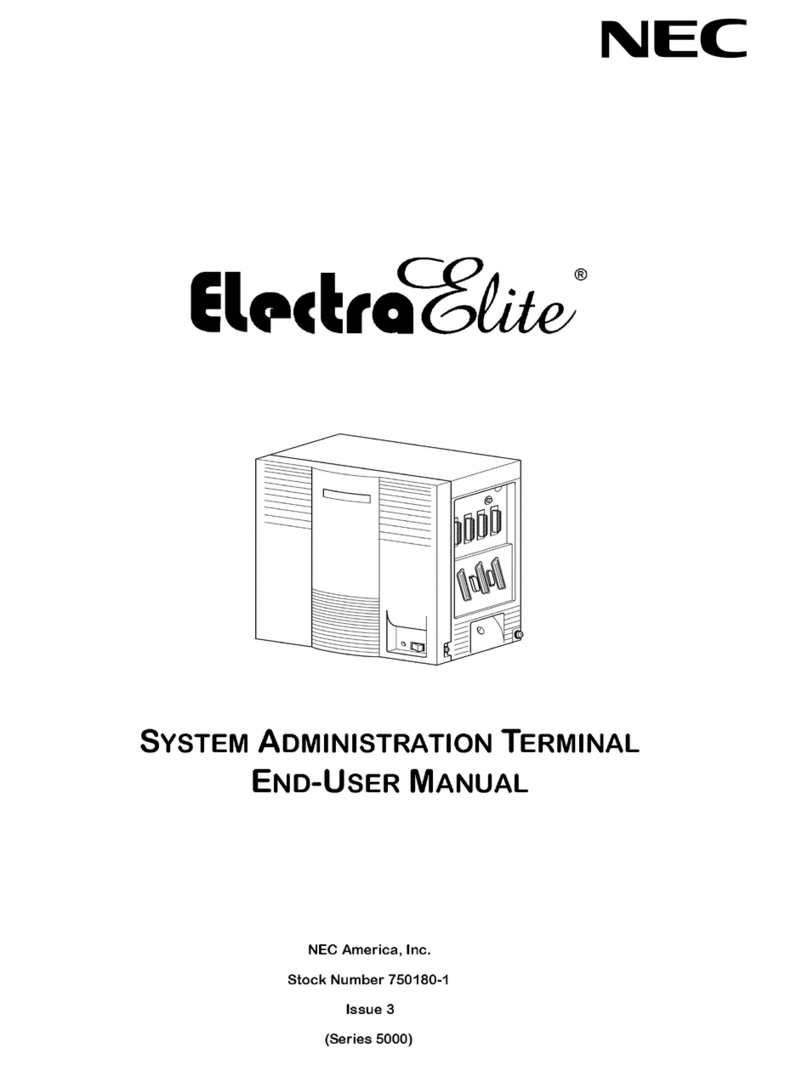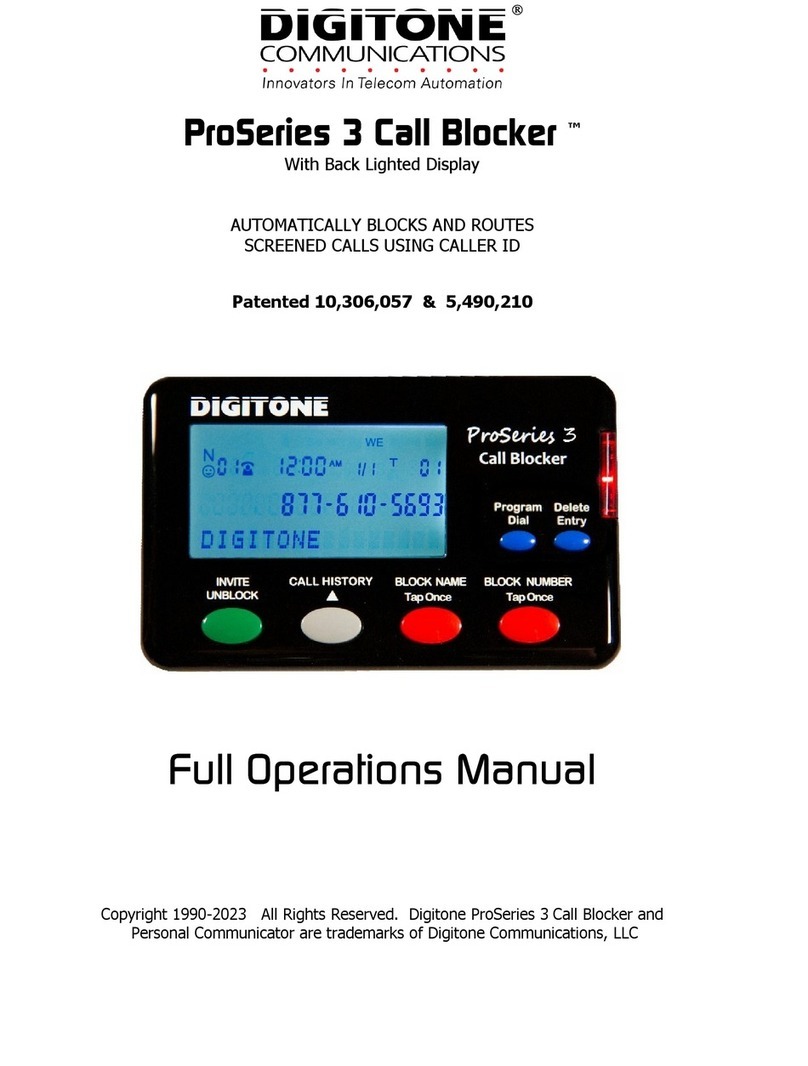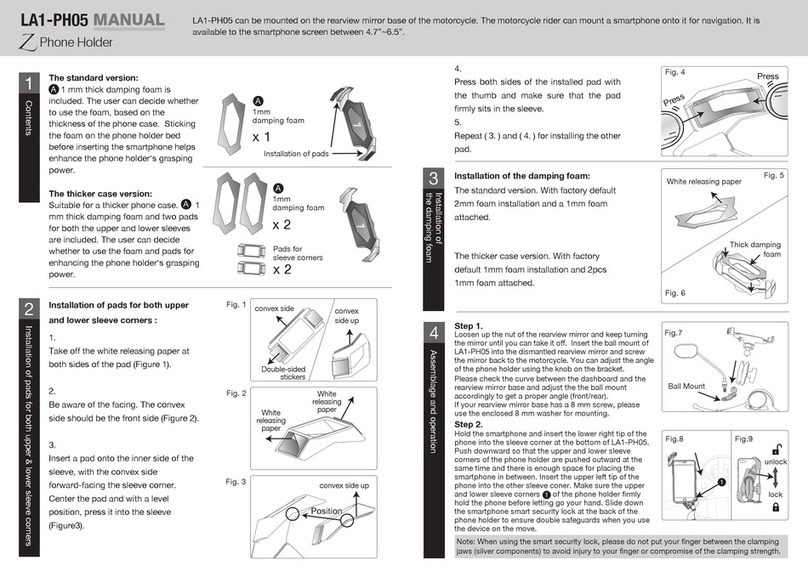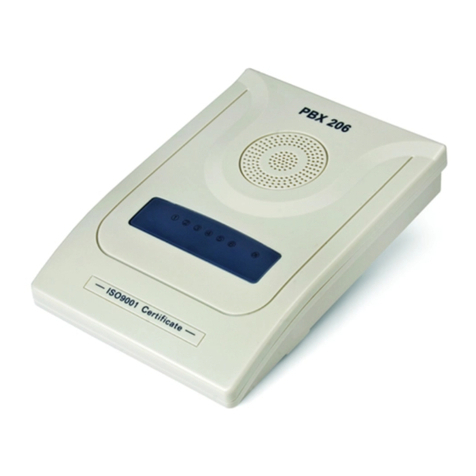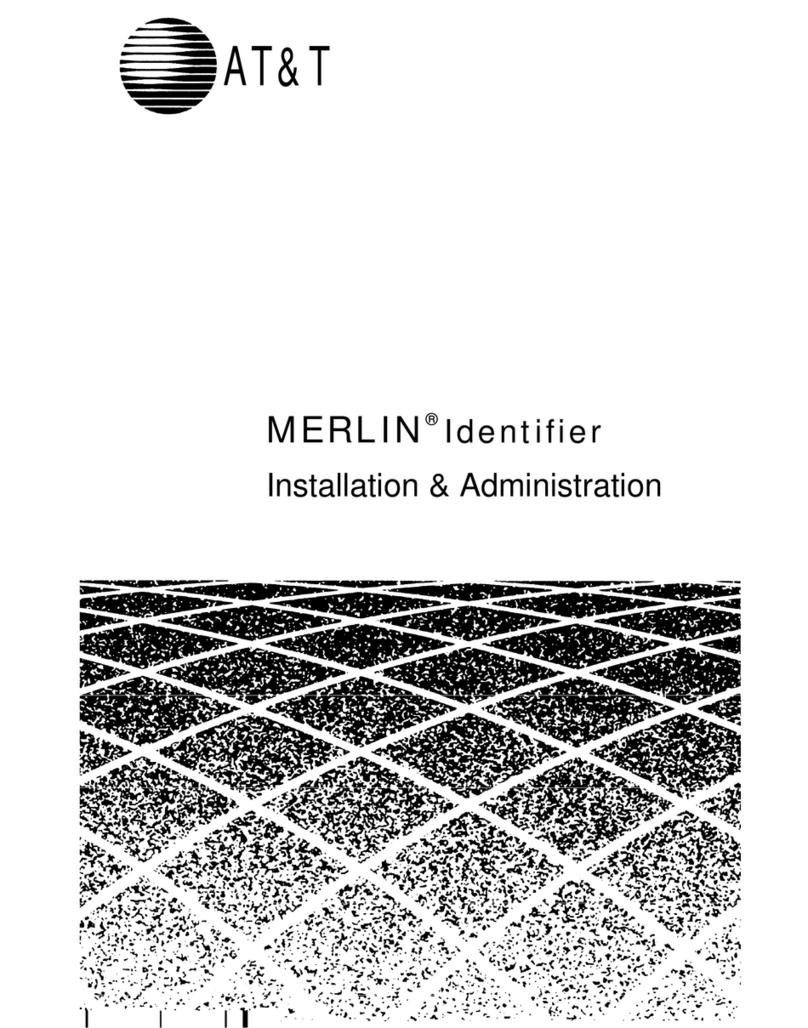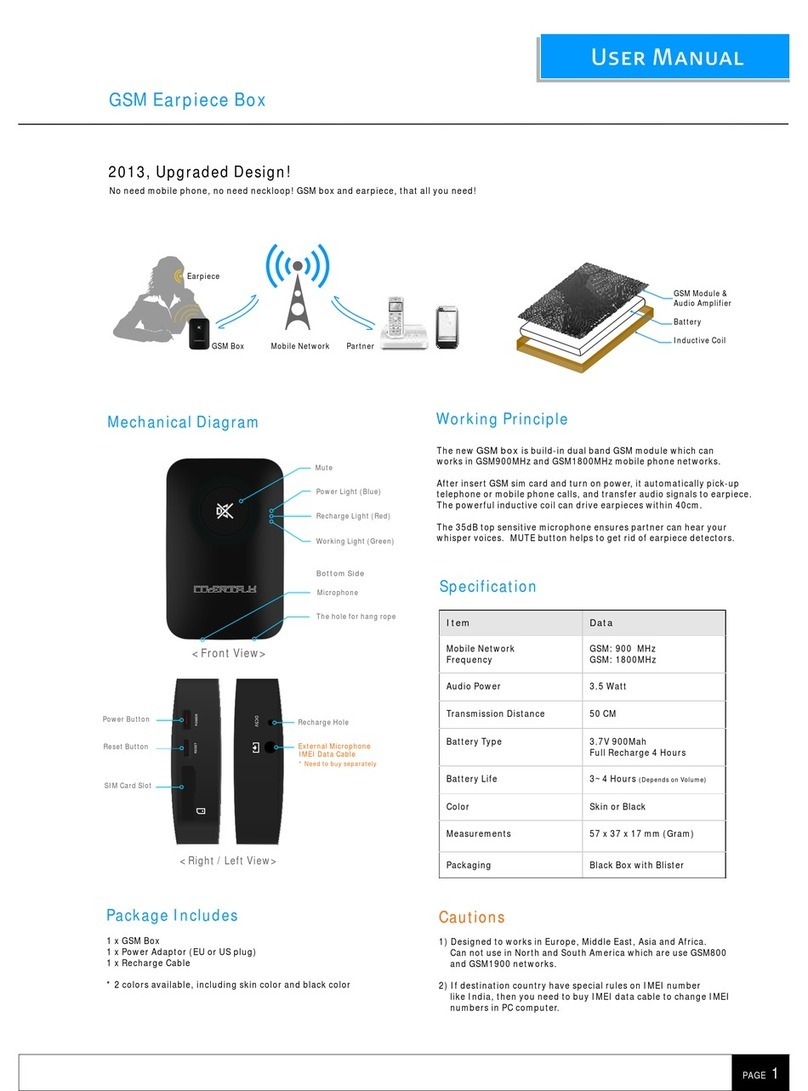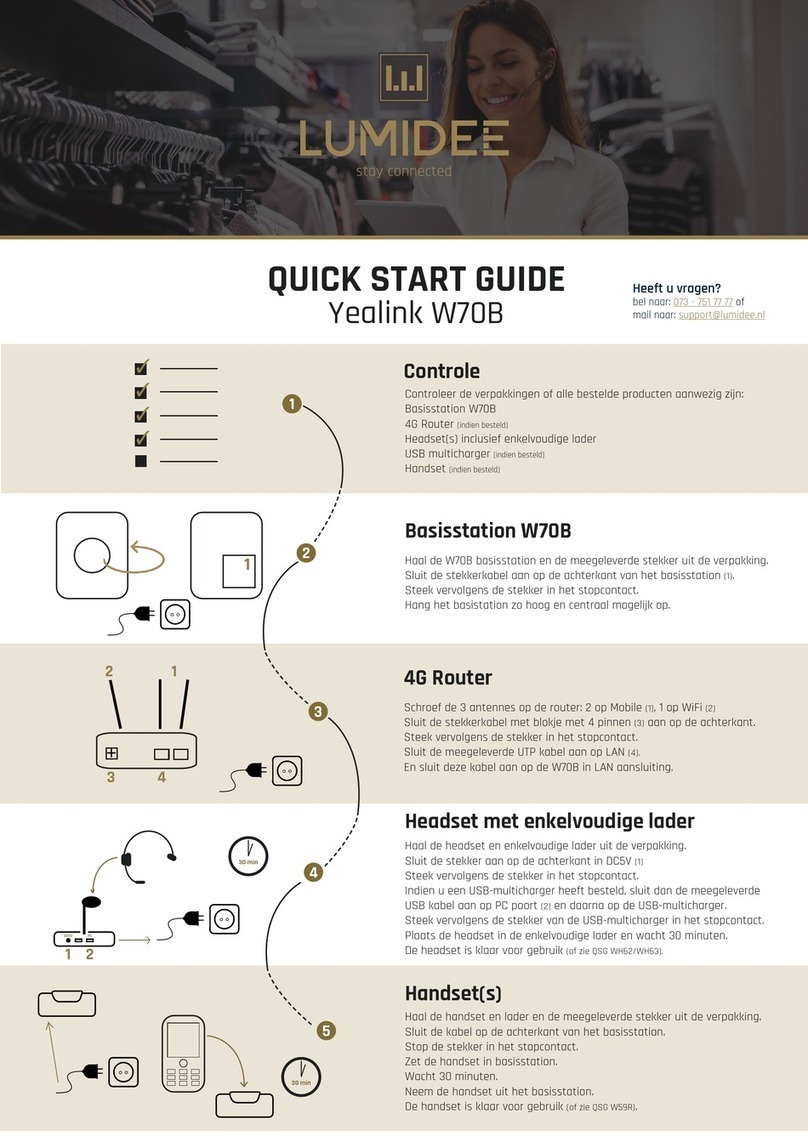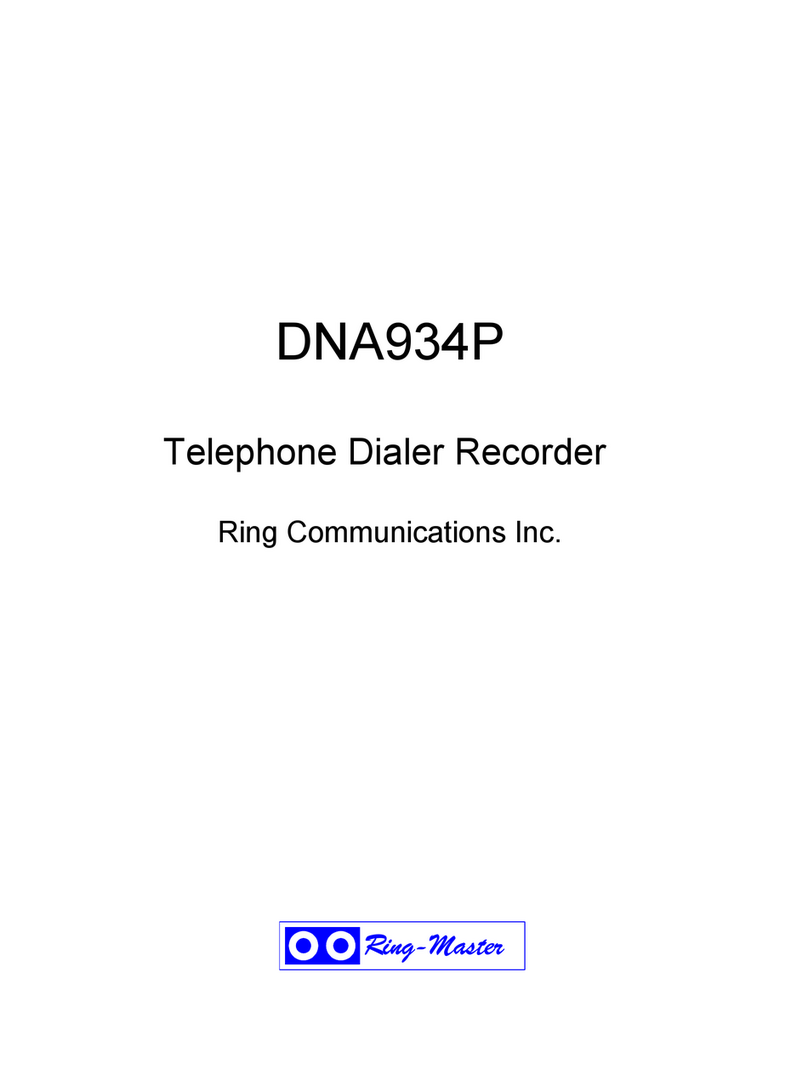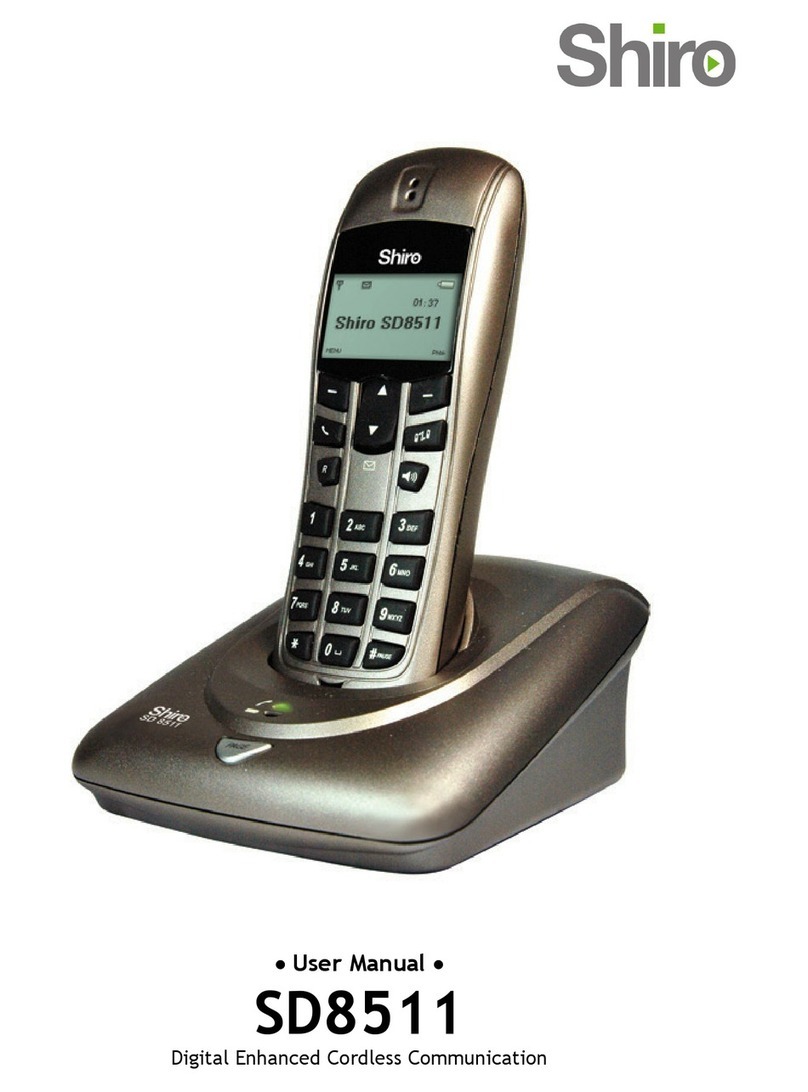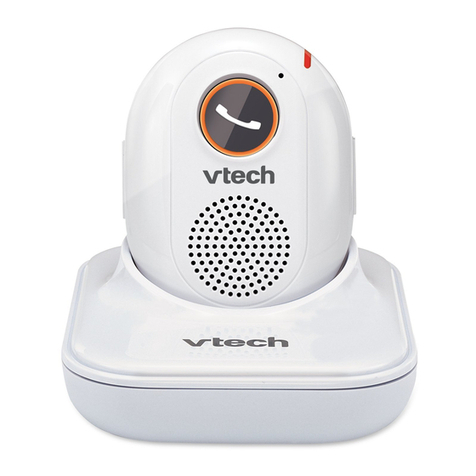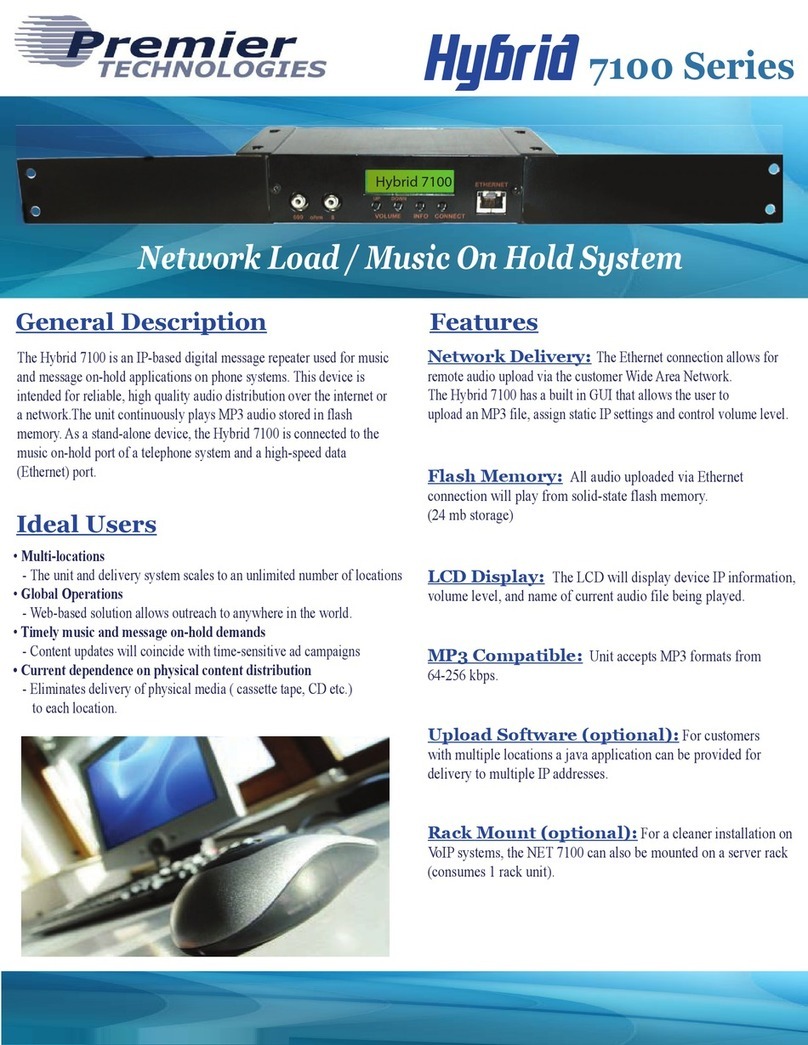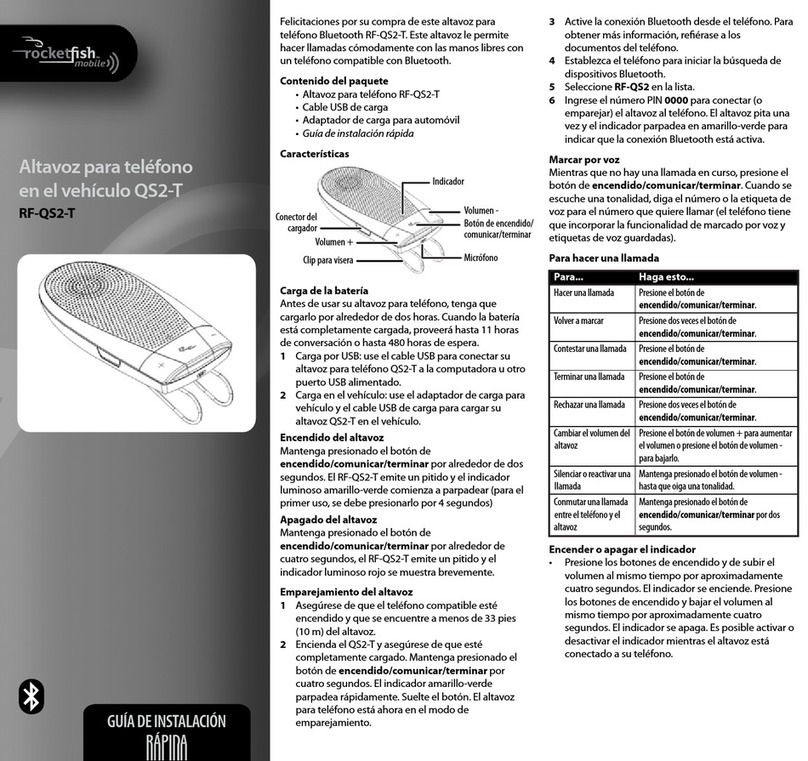Gentner SPH10 User manual

SPH10
Installation and
Operations Manual

© Copyright 1997 Gentner Communications Corporation. All rights reserved. No part of this manual may be
reproduced in any form or by any means without written permission from Gentner Communications Corporation.
Printed in the United States of America. Original version, 5/97. Gentner Communications Corporation reserves
specification privileges. Information in this manual is subject to change without notice.
SPH10 Installation and Operations Manual
Gentner Part No. 800-012-201 (Rev. 1.1)
October 1997
Manual Development: Bill Kilpack
Artwork and IIlustrations: Jim Wright, Bill Kilpack
Copyright
Information
This equipment complies with the requirements of the EU guidelines:
89/336/EEC “Electromagnetic Compatibility”
73/23/EEC “Electrical operating material for use within specific
voltage limits”
Conformity of the equipment with the above guidelines is attested by the CE mark.
Gentner Communications Corporation is committed to protecting the environment
and preserving our natural resources.
This manual has been printed entirely on recycled paper.

Contents
SPH10 Installation and Operations Manual Page iii
TechnicalorSetup Assistance
Telephone:800.945.7730 (USA)or 801.975.7200 (worldwide) •Worldwide Web @ http://www.gentner.com
Introduction 1
Warranty Registration 1
Unpacking 1
Features and Benefits 2
Product Description 2
Front-Panel Controls 2
Rear-Panel Connectors 3
Before You Install 4
Power Requirements 4
Telephone Line Requirements 4
Equipment Placement 4
Installation 4
Completed Installation 4
Step 1 — Telephone Connections 4
Step 2 — Back-Panel Connections 5
Step 3 — Power Connection 5
Mix-Minus 5
Separate Mix Channel 5
Internal Mix Bus 5
“Build Your Own” Mix-Minus 6
Discrete Microphone Mixer 6
One Channel Send 6
Operational Features 6
Remote ON/OFF Control 6
Mic/Line Select 6
Calibration 7
Step 1 — Trim Pot Levels 7
Step 2 — Caller Adjustment 7
Step 3 — Send Adjustment 7
Operation 8
Answering a Call 8
Making a Call 8
Disconnecting a Call 8
Remote Control Option 8
Recording Option 8
When Not in Use 9
Specifications 10
Warranty 11
FCC Part 15 Compliance 12
FCC Part 68 Compliance 12
IC Compliance 13

Page iv SPH10 Installation and Operations Manual
Technical orSetup Assistance
Telephone:800.945.7730 (USA)or 801.975.7200 (worldwide) •Worldwide Web @ http://www.gentner.com
Safety Information 13
BABT Recording Requirements 14
Appendix A: Connector Pinouts 15
Appendix B: Schematics 16
Contents continued
List of Figures
Figure 1. Equipment diagram 1
Figure 2. SPH10 front-panel controls 2
Figure 3. SPH10 back-panel connectors 3
Figure 4. SPH10 back-panel connectors 4
Figure 5. Typical SPH10 installation 4
Figure 6. RJ11C telephone-line connector 4
Figure 7. Remote DB25 connector 5
Figure 8. Send In audio female XLR connector 5
Figure 9. Caller Out audio male XLR connector 5
Figure 10. Aux Out audio male XLR connector 5
Figure 11. SPH10 monitor RCA jack 5
Figure 12. SPH10 power module 5
Figure 13. SPH10 dip switches 6
Figure 14. SPH10 front-panel controls 7
Figure 15. SPH10 trim-pot locations 7
Figure 16. SPH10 front-panel controls 8
Figure 17. Two typical recording configurations 9
Table 1. Remote ON/OFF Dip Switch Settings 6
Table 2. Mic/Line Select Dip Switch Settings 6
Table 3. Remote Connector Pinout 15
Table 4. Line Connector Pinout 15
Table 5. Set Connector Pinout 15
List of Tables

SPH10 Installation and Operations Manual Page 1
Technical orSetup Assistance
Telephone:800.945.7730 (USA)or 801.975.7200 (worldwide) •Worldwide Web @ http://www.gentner.com
Congratulations on purchasing the SPH10 Analog Hybrid. The SPH10 uses the
latest technology to provide high quality telephone-interface equipment. The
SPH10 is designed to interface incoming telephone calls to your audio
equipment.
The SPH10 is a single analog hybrid, allowing connection of a single external
telephone line for on-air use. When coupled with adherence to compliance
standards in the United States, Canada, the United Kingdom and mainland
Europe, the SPH10 is optimal for your telephone application.
This manual explains how to install, set up and operate the SPH10 in a step-by-
step format. It also supplies instructions on how to resolve technical problems,
should any arise.
If you need any additional information on how to install, set up or operate your
system, please contact us at Gentner Communications at the location noted
below. We welcome and encourage your comments so we can continue to
improve our products and serve your needs.
Gentner Communications Corporation
1825 Research Way
Salt Lake City, UT 84119
TEL: Worldwide 801.975.7200 In U.S.A. 800.945.7730
FAX: Worldwide 801.977.0087 In U.S.A. 800.933.5107
FAX-On-Demand 24-Hour Information Service 800.695.8110
FAX-On-Demand International Line 801.974.3661
Worldwide Web Page @ http:\\www.gentner.com
Warranty Registration
Please register your SPH10 by completing the self-addressed, postage
prepaid warranty registration card and return it to Gentner
Communications by mail. You may also FAX it to the above listed fax
number or call Gentner Communications. When your product is properly
registered, Gentner Communications will be able to serve you better should
you require technical assistance or desire to receive upgrades, new product
information, etc.
Ensure that the following items (See Figure 1, below.) were received with your
shipment:
Introduction
SHIPPING NOTE:
Gentner Communications is not responsible for product damage incurred during
shipment. You must make claims directly with the carrier. Inspect your shipment
carefully for obvious signs of damage. If the shipment appears to be damaged,
retain the original boxes and packing material for inspection by the carrier.
Contact your carrier immediately.
Unpacking
Figure 1. Equipment diagram

Page 2 SPH10 Installation and Operations Manual
Technicalor Setup Assistance
Telephone:800.945.7730 (USA) or801.975.7200 (worldwide)•WorldwideWeb@ http://www.gentner.com
Optical telephone interface
Analog filter minimizes hum and Central Office switching noise
Push-button volume control on front panel
Remote ON/OFF control via rear-panel connection
Analog send filter/limiter for telephone line-noise reduction
1W power amp (no need for headsets on guests or talent)
Balanced inputs and outputs
Downstream mixing capability
Compatible with any telephone system
RF interference will not affect performance
Simple installation and operation (no special equipment required)
The SPH10 provides superior analog telephone integration into broadcast
applications. It contains a new optical telephone interface. The SPH10 also
provides easy control of volume levels through front-panel push buttons.
Front-Panel Controls
The SPH10 front-panel controls (See Figure 2, below.) perform the following
functions:
Product
Description
Features and
Benefits
1. Send In. This trim pot adjusts the level of the send audio onto the phone
line. At its midpoint, 12 o’clock, the trim pot is set for nominal send level
(0dBm).
2. AUX Send. This trim pot will adjust the level of the aux send onto the
telephone line. At its midpoint, 12 o’clock, the trim pot is set for a nominal
level (0dBm).
3. AUX Out. This trim pot will adjust the level of the audio on the AUX
OUT connector. At its midpoint, 12 o’clock, the trim pot is set for nominal
caller level (0dBm).
4. Caller Out. This trim pot controls the caller level to the user equipment.
At its midpoint, 12 o’clock, the trim pot is set for nominal caller level
(0dBm).
5. Dip Switches. Four active dip switches (1, 3, 4, 12) configure the SPH10
system. Individual switch functions are defined in Operational Features
(Page 6).
Figure 2.SPH10 front-panel controls

SPH10 Installation and Operations Manual Page 3
Technical orSetup Assistance
Telephone:800.945.7730 (USA)or 801.975.7200 (worldwide) •Worldwide Web @ http://www.gentner.com
6. Volume. Volume. These up/down buttons control the audio level of the
MONITOR amplifier.
7. On LED. This LED indicates the hybrid’s ON state. The LED will
illuminate green when the hybrid is in the ON state.
8. Off LED. This LED indicates the hybrid’s OFF state. The LED will
illuminate red when the hybrid is in the OFF state.
9. On. The ON switch (momentary), connects the hybrid to the telephone
line.
10. Off. The OFF switch (momentary), disconnects the hybrid from the
telephone line and mutes all audio.
Rear-Panel Connectors
1. Power. The AC power cord input (See Figure 3, below.) is a NEMA type
connector allowing use of premolded domestic US power cords as well as
various other premolded international power cords.
2. Remote. This DB25 female connector provides parallel control and status
of the hybrid.
3. Monitor Out. This quarter-inch phone jack provides a 1W amplified
caller audio signal for monitoring.
4. Send In. This balanced, female 3-pin XLR input must be a mix-minus
feed.
5. Caller Out. This balanced, male 3-pin XLR output contains caller audio
only.
6. Aux Out. This balanced, male 3-pin XLR output contains caller audio
mixed with send.
7. Line. This RJ11 connector provides connection of the telephone line to
the hybrid.
8. Set. This RJ11 connector allows connection to a standard analog
telephone set. Tip and ring from the phone line are present at this connector
when the hybrid is in its OFF state. Tip and ring from the phone line are not
present at this point when the hybrid is in its ON state.
Figure 3. SPH10back-panelconnectors

Page 4 SPH10 Installation and Operations Manual
Technicalor Setup Assistance
Telephone:800.945.7730 (USA) or801.975.7200 (worldwide)•WorldwideWeb@ http://www.gentner.com
Power Requirements
The SPH10 automatically accommodates voltage requirements of 100–
240Vac, 50/60Hz, no switching required.
Telephone Line Requirements
The SPH10 models operate on standard telephone lines and connect to the
telephone system with a standard RJ11C modular jack. If you do not have an
RJ11C jack where you want to install your SPH10, call your telephone
company for installation.
DRY LINE NOTE:
The SPH10 will not operate with telephone dry Telco lines.
Equipment Placement
The SPH10 models are designed for installation into a standard 19-inch
equipment rack.
The SPH10 models are designed for easy installation and setup. All necessary
interface connections are made through rear-panel connectors. This makes for
easy installation, removal and, if necessary, service. Refer to SPH10 back-panel
connections (See Figure 4, below.) for a description and placement of each of the
connections you will be making. Each connection is numbered for easy
identification.
Completed Installation
The block diagram below (See Figure 5, below.) illustrates a typical SPH10
interconnection.
Installation
Before You
Install
To install your SPH10, follow these step-by-step instructions:
Step 1 — Telephone Connections
SPH10
Line. Plug your telephone line into the RJ11C LINE jack [7] (Figure 6, left).
Set. Plug your telephone set into the RJ11C SET jack [8].
Figure 6. RJ11Ctelephone-line connector
Figure 4. SPH10back-panelconnectors
Figure 5.Typical SPH10installation

SPH10 Installation and Operations Manual Page 5
Technical orSetup Assistance
Telephone:800.945.7730 (USA)or 801.975.7200 (worldwide) •Worldwide Web @ http://www.gentner.com
Step 2 — Back-Panel Connections
Remote Control
If using a remote control for parallel control and hybrid status, plug it into
the DB25 REMOTE connector [2] (Figure 7, left). For pinouts, see
Appendix A: Connector Pinouts (Page 13).
Send In
Connect the SEND IN female XLR plug [5] (See Figure 8, left.) to the studio
console. This is balanced line-level audio.
Caller Out
Connect the SPH10’s CALLER OUT audio output to an input on your audio
console [5] (Figure 9, left). This male XLR socket’s audio must contain a
mix-minus.
Aux Out
Connect his male XLR connector [6] (See Figure 10, left, bottom.) to your
recording device. This connector contains caller audio only. Select the AUX
Mix dip switch to create a mix of send and caller on this connector.
Monitor Out
Connect a speaker output feed to this quarter-inch TRS jack [3] (See Figure
11, left.) to monitor a 1W-amplified caller signal.
Step 3 — Power Connection
The power cord [1] (See Figure 12, left.) will operate at any level between
100–240Vac, 50–60Hz.
Mix-minus refers to the audio that must be sent to callers to prevent feedback on
the audio system through the hybrid. Mix-minus is a mix of all audio on the
console, minus the caller’s audio. Without a mix-minus feed, the caller audio
appearing on the console will be sent back to the caller, where it will be
retransmitted to the studio via the caller’s telephone. This feedback can create
anything from echo to a howling squeal. Many broadcast consoles provide a mix-
minus feed via a telephone module.
When using the SPH10 with mix-minus, there are several ways of going about
generating external mix-minus. If a mixing console is used to feed the SPH10’s
SEND input, the audio going down the line must not contain any caller audio.
There are five ways to accomplish this: separate mix channel, internal mix bus,
“build your own” mix-minus, discrete microphone mixer and one-channel send.
Separate Mix Channel
If the console has an extra mixing output channel, use this channel to mix all
the audio you want to send to the SPH10 except the channel that will be
connected to caller audio.
Internal Mix Bus
Mix-minus refers to a sum of all the audio sources in the console minus the
caller audio. Many console manufacturers provide this feature as a telephone
module.
Figure 7.Remote DB25 connector
Figure 12. SPH10power module
Mix-Minus
Figure 11. SPH10monitor RCA jack
Figure 8. SendIn femaleXLRconnector
Figure 9. CallerOut male XLR connector
Figure 10. AuxOut male XLR connector

Page 6 SPH10 Installation and Operations Manual
Technicalor Setup Assistance
Telephone:800.945.7730 (USA) or801.975.7200 (worldwide)•WorldwideWeb@ http://www.gentner.com
Remote ON/OFF Control
Dip switch 3 (See Figure 13, left.) determines the type of external control
used to turn the hybrid ON and OFF (Table 1, below).
Operational
Features
“Build Your Own” Mix-Minus
You can build your own mix-minus by externally summing all audio sourced
to be sent to the caller.
Discrete Microphone Mixer
If only microphone audio will be sent down the line, a separate microphone
mixer (such as the Gentner MPAII Mixer/Power Amplifier) may be utilized.
This audio can then be sent to the SPH10’s SEND input as well as the
console input.
One Channel Send
If a single-source audio will be sent to the caller (i.e. from a microphone),
simply use the line-level output from the microphone preamplifier.
Mix-Minus
Continued
Table 1. Remote ON/OFF Dip Switch Settings
Dip Switch Position Description
3 ON (UP) Momentary
3 OFF (DOWN) Latching
Mic/Line Select
Dip switch 4 determines the SEND input’s gain. When this dip switch is
selected, the input will provide 55dB of gain to provide for an external
microphone connection (Table 2, below).
Table 2. Mic/Line Select Dip Switch Settings
Dip Switch Position Description
4 ON (UP) +55dB (Mic)
4 OFF (DOWN) 0dB (Line)
Figure 13. SPH10dip switches

SPH10 Installation and Operations Manual Page 7
Technical orSetup Assistance
Telephone:800.945.7730 (USA)or 801.975.7200 (worldwide) •Worldwide Web @ http://www.gentner.com
Calibration The following information will help you make adjustments to optimize your
system performance. Verify all components and all connections. Ensure that
proper power is supplied to the SPH10 and that the unit is OFF (the red OFF
LED [7] will be lit; Figure 14, below). If the green ON LED [6] is lit, press the
OFF button [9].
Step 1 — Trim Pot Levels
Due to the various operating modes front-panel level settings will need to be
preset as follows:
Set both the SEND IN trim pot [1] and CALLER OUT trim pot [4] at the 12
o’clock position (Figure 15, left).
Step 2 — Caller Adjustment
From another location, have someone call the SPH10. Answer the line by
pressing the ON button [9].
As the caller talks, adjust only the CALLER OUT trim pot [4] identified in
Step 1 (above), and/or your mixing board for a correct level going into your
board.
Step 3 — Send Adjustment
Provide normal program audio to the hybrid’s SEND IN input. Adjust your
console or active SEND IN trim pot [1] until the caller verifies that this is a
comfortable listening level.
Conclude your conversation and press the OFF button [10].
Figure 14. SPH10front-panel controls
Figure 15. SPH10 trim-pot locations

Page 8 SPH10 Installation and Operations Manual
Technicalor Setup Assistance
Telephone:800.945.7730 (USA) or801.975.7200 (worldwide)•WorldwideWeb @http://www.gentner.com
Easy-to-access and read front-panel controls make operation of the SPH10
simple. Figure 16 (below) shows each front panel LED and button by number.
Operation
Answering a Call
An incoming call will ring on the telephone set connected to the SPH10.
Answer the call by pressing the ON button [2] on either the front panel or
from your remote control. This will route the call through the SPH10, and
the green ON LED [4] will light. The red OFF LED [5] will extinguish.
Or
If you want to talk off-air, you can answer the call by picking up the
telephone handset and talking to your party over the telephone. Do not
activate the SPH10.
Making a Call
Off-Air
The SPH10 should be OFF (the red OFF LED [5] will be lit). Using your
telephone set, dial the phone number of the party you wish to call. Conduct
your call as you normally would and hang up the handset when finished.
On-Air
Call the party using your telephone set. After the other party has answered,
put the call on-air by pressing the ON button [2]. The ON LED [4] will light
and the SPH10 will take control of the call, disabling the telephone set. You
may safely hang up the handset without disconnecting your call. When the
conversation is complete, press the OFF button [3] to disconnect the call.
Disconnecting a Call
If the call is routed through the SPH10 (the ON LED [4] will be lit), press
the OFF button [3]. The OFF LED [5] will light, and the ON LED [4] will
extinguish.
If your call is through the handset only (the red OFF LED [5] will be lit),
hang up when the conversation is complete.
Remote Control Option
The remote control connector can be used to perform three functions:
monitor mute on/off, system on and system off.
If using a remote-control device, internal dip switch 3 will select a
momentary or latching ON closure. See Table 2, Page 6.
Recording Option
To record a call, your recording device must be connected to the AUX OUT
connector on the SPH10’s back panel. While on a connected call, the mix of
Figure 16. SPH10front-panel controls

SPH10 Installation and Operations Manual Page 9
Technical orSetup Assistance
Telephone:800.945.7730 (USA)or 801.975.7200 (worldwide) •Worldwide Web @ http://www.gentner.com
both send and receive audio will be routed to the AUX connector. See Figure
17 (below) for possible configurations. Turn on your recording device and
set it to record. Turn the recording device off when the call is finished.
When Not in Use
The SPH10 is inactive when the red OFF LED [7] lit.
POWER NOTE:
Power should be maintained to the unit at all times.
Figure 17.Twotypical recording
configurations

Page 10 SPH10 Installation and Operations Manual
Technicalor Setup Assistance
Telephone:800.945.7730 (USA) or801.975.7200 (worldwide)•WorldwideWeb @http://www.gentner.com
SPH10
Dimensions
17"/43.2cmW x 1.75"/4.5cmH x 8"/25.4cm D
Weight
7 lbs/3.2kg (dry) 12.1 lbs./5.5kg (shipping)
Connectors
POWER: Auto-adjusting power module from 100–240Vac, 50/60Hz
REMOTE: DB25 female connector.
MONITOR OUT: 1/4" stereo jack; tip = +phase, ring = -phase; sleeve =
analog ground, 1W output into an 8ohm load
SEND IN: 3-pin female XLR; pin 1 = analog ground, pin 2 =
+phase, pin 3 = -phase; +20dBm maximum input, -10dBu
nominal level, >20kOhm impedance
CALLER OUT: 3-pin male XLR; pin 1 = analog ground, pin 2 = +phase,
pin3 = -phase; +20dBm maximum into 600 Ohms, 0dBu
nominal level
AUX OUT: 3-pin male XLR; pin 1 = analog ground, pin 2 = +phase,
pin3 = -phase; +20dBm maximum into 600 Ohms, 0dBu
nominal level
LINE: RJ11 connector; A-lead supervision provided
SET: RJ11 connector
Power Requirements
100–240Vac, 50/60Hz, 30W
Audio Performance
Frequency Response
1dB from 250Hz to 3.5kHz (with AGC disabled)
Signal-to-Noise Ratio
>56dB reference to 0dBu at -15dBm on the telephone line
Receive Audio: Distortion
<.3% THD, 250Hz to 3.5kHz (AGC disabled)
Remote
Unbalanced Audio Out
0dBu line level output with a <50ohm impedance
Unbalanced Audio In
0dBu line level >20kohm impedance
On/Off Control
Momentary closures to the switch common, unless latching-mode enabled
Specifications

SPH10 Installation and Operations Manual Page 11
Technical orSetup Assistance
Telephone:800.945.7730 (USA)or 801.975.7200 (worldwide) •Worldwide Web @ http://www.gentner.com
(dip-switch option); latching mode, hybrid remains active while closure from
the ON control to switch common is present (OFF control nonfunctional in
this mode).
Send and Caller Presence Indication
Open collector outputs go low when send and/or caller levels are nominal
Monitor Mute
Control input mutes monitor output with closure from mute input to switch
common
Operating Temperature
32–100° F / 0–38° C
Humidity
0–80 percent
All specifications are subject to change without notice.
Warranty
Gentner Communications Corporation (Manufacturer) warrants that this product is free of defects in both materials and
workmanship. Should any part of this equipment be defective, the Manufacturer agrees, at its option, to:
A. Repair or replace any defective part free of charge (except transportation charges) for a period of one
year from the date of the original purchase, provided the owner returns the equipment to the Manufacturer at the
address set forth below. No charge will be made for parts of labor during this period;
B. Furnish replacement for any defective parts in the equipment for a period of one year from the date of original
purchase. Replacement parts shall be furnished without charge, except labor and transportation.
This Warranty excludes assembled products not manufactured by the Manufacturer whether or not they are
incorporated in a Manufacturer product or sold under a Manufacturer part or model number.
THIS WARRANTY IS VOID IF:
A. The equipment has been damaged by negligence, accident, act of God, or mishandling, or has not been operated in
accordance with the procedures described in the operating and technical instructions; or,
B. The equipment has been altered or repaired by other than the Manufacturer or an authorized service representative
of the Manufacturer; or,
C. Adaptations or accessories other than those manufactured or provided by the Manufacturer have been made or
attached to the equipment which, in the determination of the Manufacturer, shall have affected the performance, safety
or reliability of the equipment; or,
D. The equipments original serial number has been modified or removed.
NO OTHER WARRANTY, EXPRESS OR IMPLIED, INCLUDING WARRANTY OF MERCHANTABILITY OR
FITNESS FOR ANY PARTICULAR USE, APPLIES TO THE EQUIPMENT, nor is any person or company authorized
to assume any warranty for the Manufacturer or any other liability in connection with the sale of the Manufacturer's
products.
Manufacturer does not assume any responsibility for consequential damages, expenses, or loss of revenue or property,
inconvenience, or interruption in operation experienced by the customer due to a malfunction in the purchased
equipment. No warranty service performed on any product shall extend the applicable warranty period.
In case of unsatisfactory operation, the purchaser shall promptly notify the Manufacturer at the address set forth below
in writing, giving full particulars as to the defects or unsatisfactory operation. Upon receipt of such notice, the
Manufacturer will give instructions respecting the shipment of the equipment, or such other matters as it elects to
honor this warranty as above provided. This warranty does not cover damage to the equipment during shipping and the
Manufacturer assumes no responsibility for such damage. All shipping costs shall be paid by the customer.
This warranty extends only to the original purchaser and is not assignable or transferable.
Gentner Communications Corporation, 1825 Research Way, Salt Lake City, Utah 84119

Page 12 SPH10 Installation and Operations Manual
Technicalor Setup Assistance
Telephone:800.945.7730 (USA) or801.975.7200 (worldwide)•WorldwideWeb @http://www.gentner.com
This equipment has been tested and found to comply with the limits for a Class B digital device, pursuant to Part 15 of
the FCC rules. These limits are designed to provide reasonable protection against harmful interference when the
equipment is operated in a commercial environment. This equipment generates, uses, and can radiate radio frequency
energy and, if not installed and used in accordance with the instruction manual, may cause harmful interference to
radio communications. Operation of this equipment in a residential area is likely to cause harmful interference, in
which case the user will be required to correct the interference at his/her own expense.
Changes or modifications not expressly approved by Gentner Communications Corporation could void the user’s
authority to operate the equipment.
FCC Registration Number: FBIUSA-31573-BR-N
Ringer Equivalence Number (REN): 1.1B
A label containing, among other information, the FCC registration number and Ringer Equivalence Number (REN) for
this equipment is prominently posted on the top plate, near the rear of the equipment. If requested, this information
must be provided to your telephone company.
USOC Jacks: This device uses RJ11C and RJ21X terminal jacks.
The REN is used to determine the quantity of devices which may be connected to the telephone line. Excessive RENs
on the telephone line may result in the devices not ringing in response to an incoming call. In most, but not all areas,
the sum of the RENs should not exceed five (5). To be certain of the number of devices that may be connected to the
line, as determined by the total RENs, contact the telephone company to obtain the maximum RENs for the calling
area.
If this equipment causes harm to the telephone network, the telephone company will notify you in advance that
temporary discontinuance of service may be required. If advance notice is not practical, the telephone company will
notify the customer as soon as possible. Also, you will be advised of your right to file a complaint with the FCC if you
believe it is necessary.
The telephone company may make changes in its facilities, equipment, operations, or procedures that could affect the
operation of the equipment. If this happens, the telephone company will provide advance notice for you to make the
necessary modifications in order to maintain uninterrupted service.
If you experience problems with this equipment, contact Gentner Communications Corporation, 1825 Research Way,
Salt Lake City, Utah 84119, or by phone at (801) 975-7200 for repair and warranty information. If the trouble is
causing harm to the telephone network, the telephone company may request you remove the equipment from the
network until the problem is resolved.
No user serviceable parts are contained in this product. If damage or malfunction occurs, contact Gentner
Communications for instructions on its repair or return.
This equipment cannot be used on telephone company provided coin service. Connection to Party Line Service is
subject to state tariffs.
FCC Part 68
Compliance
FCC Part 15
Compliance

SPH10 Installation and Operations Manual Page 13
Technical orSetup Assistance
Telephone:800.945.7730 (USA)or 801.975.7200 (worldwide) •Worldwide Web @ http://www.gentner.com
Safety
Information
IC Compliance
NOTICE: The Industry of Canada label identifies certified equipment. This certification means that the equipment
meets certain telecommunications network protective operational and safety requirements. The Department does not
guarantee the equipment will operate to the user's satisfaction.
Before installing this equipment, users should ensure that it is permissible to be connected to the facilities of the local
telecommunications company. The equipment must also be installed using an acceptable method of connection. In some
cases, the company's inside wiring associated with a single line individual service may be extended by means of a
certified connector assembly (telephone extension cord). The customer should be aware that compliance with the above
conditions may not prevent degradation of service in some situations.
Repairs to certified equipment should be made by an authorized Canadian maintenance facility designated by Gentner
Communications. Any repairs or alterations made by the user to this equipment, or equipment malfunctions, may give
the telecommunications company cause to request the user to disconnect the equipment.
Users should ensure for their own protection that the electrical ground connections of the power utility, telephone lines
and internal metallic water pipe system, if present, are connected together. This precaution may be particularly
important in rural areas.
Ringer Equivalence Number (REN): 1.1
IC Certification Number: 1970 8175 A
CAUTION: Users should not attempt to make such connections themselves, but should contact the appropriate
electrical inspection authority, or electrician, as appropriate.

Page 14 SPH10 Installation and Operations Manual
Technicalor Setup Assistance
Telephone:800.945.7730 (USA) or801.975.7200 (worldwide)•WorldwideWeb @http://www.gentner.com
This condition applies in circumstances where you wish to use telecommunications apparatus comprised in or
connected to your system to record, silently monitor or intrude into live-speech telephone calls. (It does not apply
where the apparatus in question is not telecommunications apparatus; i.e. is not apparatus that had been constructed or
adapted for use in transmitting or receiving telecommunications messages.) Silent monitoring is the establishment of a
receive-only transmission path to a third terminal, enabling a third party to hear the call. Instrusion is the
establishment of a bothway speech transmission to another terminal enabling a third party to hear and be heard by at
least one of the other parties to the call. The condition does not apply to the monitoring of telephone calls for a systems
control or diagnostic purposes where the meaningful content of the call itself is monitored.
This condition provides that you should make every reasonable effort to inform all parties to a call that it may or will be
recorded, silently monitored or intruded into. The particular means by which you choose to do this are not specified in
the condition. Acceptable options, depending on circumstances, might include warning tones, prerecorded messages,
spoken warnings by the operator or written warnings included in publicity material, telephone directories, contracts,
terms of business, staff notices, etc. It may not always be possible to warn first-time callers with whom you have had
no previous contact but what is important is that you have a systemic procedure in place which provides the necessary
information wherever this is a realistic possibility.
For recording and silent monitoring, this condition recognises two forms of warning: a written notice before the call or
a warning during the call itself. Both warnings should also inform all parties to a call why it is being recorded or
silently monitored. In the case of intrusion, a warning before the intrusion takes place is sufficient as both parties will
become aware that a third party has joined their conversation.
This condition does not specify the detail of how these forms of warning should be given. A written statement included
in any of the following — contractural terms, conditions of employment, publicity material, staff notices, telephone
directory entries — would be a possible method.
The essential point is that the equipment user must be able to demonstrate that a determined attempt has been made to
reach prospective callers; as an illustration, we would expect any warning included in a company’s publicity material to
be presented in such a way that it would not be missed by anyone looking for that company’s telephone number(s). A
warning which is not clearly visibly would fail to meet this requirement.
Where the warning is to be given during the call itself, the possibilities include a recorded message at the beginning of
the call or a spoken message at any time during the conversation.
You should also maintain a record of the means by which callers have been warned which the Director may request
sight of. This does not mean that you have to log each phone call; rather, that should a dispute arise, it will be possible
for you to show from records how callers were being made aware at the time.
This condition does not apply where apparatus is being used for the purpose of law enforcement or in the interests of
national security or to calls involved the national Emergency Organisations. It also provides that other licensees may
be excluded, by means of a Director’s consent, where there are compelling factors that outweigh the normal expectation
of privacy. Such factors might apply where security is a consideration or in the case of specialised users such as
helplines. In accordance with Section 19 of the Telecommunications Act of 1984, these consents will be entered on a
register open to public inspection.
This condition attempts to secure objectives similar to those which weere previously achieved through an approval
requirement that equipment capable of recording, silently monitoring or intruding into telephone conversations should
emit warning tones as these operations take place. The removal of warning tones was permitted by an OFTEL General
Variation provided that an alternative form of warning was given. The expectation is that procedures complying with
the General Variation should, generally, also meet the requirements of this condition.
BABT Recording
Requirements

SPH10 Installation and Operations Manual Page 15
Technical orSetup Assistance
Telephone:800.945.7730 (USA)or 801.975.7200 (worldwide) •Worldwide Web @ http://www.gentner.com
Appendix A:
Connector Pinouts
Table 4. Remote Connector Pinout
Pin Description Pin Description
1 Remote hybrid 1 ON * 14 Hybrid 1 ON indication **
2 Remote hybrid 1 OFF * 15 Hybrid 1 OFF indication **
3 N/C 16 N/C
4 N/C 17 N/C
5 Switch/Indicator Common 18 Switch/Indicator Common
6 N/C 19 Hybrid 1 send presence indicator **
7 N/C 20 Hybrid 1 caller presence indicator **
8 N/C 21 Switch/Indicator Common
9 Unbalanced Send Audio Input (0dBu nominal) 22 Audio Common
10 Unbalanced Caller Audio Output (0dBu nominal) 23 Audio Common
11 Unbalanced Aux Audio Output (0dBu nominal) 24 Audio Common
12 Monitor Mute Control* 25 Switch/Indicator Common
13 Audio Common
* Remote control provided via contact closure to Switch/Indicator Common
** Remote indicators provided via open collector outputs to Indicator Common (<15V, <39mA)
Table 5. Line Connector Pinout
Pin Description Pin Description
1 To pin 6 of SET RJ11C 4 Ring
2 To pin 5 of SET 5 To pin 2 of SET
3 Tip 6 To pin 1 of SET RJ11C
Table 6. Set Connector Pinout
Pin Description Pin Description
1 To pin 6 of LINE RJ11C 4 Tip
2 To pin 5 of LINE RJ11C 5 To pin 2 of LINE RJ11C
3 Ring 6 To pin 1 of LINE RJ11C

Page 16 SPH10 Installation and Operations Manual
Technicalor Setup Assistance
Telephone:800.945.7730 (USA) or801.975.7200 (worldwide)•WorldwideWeb @http://www.gentner.com
Appendix B:
Schematics
Other manuals for SPH10
1
Table of contents
Other Gentner Telephone Accessories manuals


